Ink wash painting
Ink wash painting[1] is a type of East Asian brush painting that uses the same black ink used in East Asian calligraphy in different concentrations. Emerging in Tang dynasty China (618–907), it overturned earlier, more realistic techniques. It is typically monochrome, using only shades of black, with a great emphasis on virtuoso brushwork and conveying the perceived "spirit" or "essence" of a subject over the direct imitation.[2][3][4] It flourished from the Song dynasty in China (960–1279) onwards, as well as in Japan after it was introduced by Zen Buddhist monks in the 14th century.[5] Somewhat later, it became important in Korean painting.
| Ink wash painting | |||||||
|---|---|---|---|---|---|---|---|
 Liang Kai (Chinese: 梁楷, 1140-1210), Drunken Celestial (Chinese: 潑墨仙人), 12th century, Southern Song (Chinese), Taipei Palace Museum, Taipei | |||||||
| Chinese name | |||||||
| Traditional Chinese | 水墨畫 | ||||||
| Simplified Chinese | 水墨画 | ||||||
| |||||||
| Korean name | |||||||
| Hangul | 수묵화 | ||||||
| Hanja | 水墨畵 | ||||||
| |||||||
| Japanese name | |||||||
| Kanji | 1. 水墨画 2. 墨絵 | ||||||
| Hiragana | 1. すいぼくが 2. すみえ | ||||||
| |||||||
In China and Japan, but much less so in Korea, ink wash painting formed a distinct stylistic tradition, with a different set of artists working in it from those doing other types of painting. Especially in China, it was a gentlemanly occupation associated with poetry and calligraphy, and often produced by the scholar-official or literati class, ideally illustrating their own poetry, and producing the paintings as gifts for friends or patrons, rather than painting for payment. In practice a talented painter often had a very useful advantage in climbing the bureaucratic ladder. Korean painters were less segregated, and more ready to paint in two techniques, and also to mix areas of colour with monochrome ink, for example in painting the faces of figures.[4][2]
The very vertical hanging scroll was the classic format; the long horizontal handscroll format tended to be associated with professional coloured painting, but was also used for literati painting. In both formats, paintings were generally kept rolled up, and brought out for the owner to admire, often with a small group of friends.[6] Chinese collectors liked to stamp paintings with their seals, usually in red ink, and sometimes added poems or notes of appreciation. Some old and famous paintings have become rather disfigured by this; the Qianlong Emperor was a particular offender.[3]
In landscape painting the scenes depicted are typically imaginary, or very loose adaptations of actual views. The shan shui style of mountain landscapes are by far the most common, often evoking particular areas traditionally famous for their beauty, from which the artist may have been very distant. Water is very often included.[4][7]

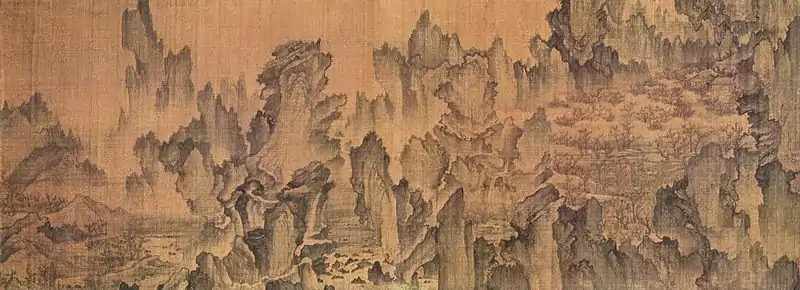
_-_right_hand_screen.jpg.webp)
History
In Chinese painting, brush painting was one of the "Four Arts" expected to be learnt by China's class of scholar-officials.[5] Ink wash painting appeared during the Tang dynasty (618–907), and its early development is credited to Wang Wei and Zhang Zao, among others.[4]
In the Ming dynasty, Dong Qichang would identify two distinct styles: a clearer, grander Northern School (北宗画 or 北画, C: Beizonghua or Beihua, J: Hokushūga or Hokuga), and a freer, more expressive Southern School (南宗画 or 南画, C: Nanzonghua or Nanhua, J: Nanshūga or Nanga), also called "Literati Painting" (文人画, C: Wenrenhua, J: Bunjinga).[2][8][9][10]
In Japan, the style was introduced in the 14th century, during the Muromachi period (1333–1573) through Zen Buddhist monasteries,[11] and in particular Josetsu, a painter who immigrated from China and taught the first major early painter Tenshō Shūbun (d. by 1450). Both he and his pupil Sesshū Tōyō (1420–1506) were monks, although Sesshū eventually left the clergy, and spent a year or so in China in 1468-69.[12] By the end of the period the style had been adopted by several professional or commercial artists, especially from the large Kanō school founded by Kanō Masanobu (1434–1530); his son Kanō Motonobu was also very important. In the Japanese way, the most promising pupils married daughters of the family, and changed their names to Kanō. The school continued to paint in the traditional Japanese yamato-e and other coloured styles as well.[9][3]
A Japanese innovation of the Azuchi–Momoyama period (1568-1600) was to use the monochrome style on a much larger scale in byōbu folding screens, often produced in sets so that they ran all round even large rooms. The Shōrin-zu byōbu of about 1595 is a famous example; only some 15% of the paper is painted.[13]
The smaller, more purist and less flamboyant Hasegawa school was founded by Hasegawa Tōhaku (1539-1610), and lasted until the 18th century. The nanga (meaning "Southern painting") or bunjinga ("literati") style or school ran from the 18th century until the death of Tomioka Tessai (1837–1924) who was widely regarded as the last of the nanga artists.[8][9]
In Korea, the Dohwaseo or court academy was very important, and most major painters came from it, although the emphasis of the academy was on realistic decorative works and official portraits, so something of a break from this was required.[14] However the high official and painter Gang Se-hwang and others championed amateur literati or seonbi painting in the Chinese sensibility. Many painters made both Chinese-style landscapes and genre paintings of everyday life, and there was a tradition of more realistic landscapes of real locations, as well as mountains as fantastical as any Chinese paintings, for which the Taebaek Mountains along the eastern side of Korea offered plenty of inspiration.[15]
In all three countries, brush painting remains popular with amateurs, and some professional artists, and continues to influence other modern styles of art.[4][3]
Philosophy
East Asian writing on aesthetics is generally consistent in stating that the goal of ink and wash painting is not simply to reproduce the appearance of the subject, but to capture its spirit. To paint a horse, the ink wash painting artist must understand its temperament better than its muscles and bones. To paint a flower, there is no need to perfectly match its petals and colors, but it is essential to convey its liveliness and fragrance. In this, it has been compared to the later Western movement of Impressionism.[2] It is also particularly associated with the Chán or Zen sect of Buddhism, which emphasises "simplicity, spontaneity and self-expression", and Daoism, which emphasises "spontaneity and harmony with nature,"[5] especially when compared with the less spiritually-oriented Confucianism.[4]
East Asian ink wash painting has long inspired modern artists in the West. In his classic book Composition, American artist and educator Arthur Wesley Dow (1857–1922) wrote this about ink wash painting: "The painter... put upon the paper the fewest possible lines and tones; just enough to cause form, texture and effect to be felt. Every brush-touch must be full-charged with meaning, and useless detail eliminated. Put together all the good points in such a method, and you have the qualities of the highest art".[16] Dow's fascination with ink wash painting not only shaped his own approach to art but also helped free many American modernists of the era, including his student Georgia O'Keeffe, from what he called a "story-telling" approach. Dow strived for harmonic compositions through three elements: line, shading, and color. He advocated practicing with East Asian brushes and ink to develop aesthetic acuity with line and shading.[4][8]
Technique
Ink wash painting uses tonality and shading achieved by varying the ink density, both by differential grinding of the ink stick in water and by varying the ink load and pressure within a single brushstroke. Ink wash painting artists spend years practicing basic brush strokes to refine their brush movement and ink flow. These skills are closely related to those needed for basic writing in East Asian characters, and then for calligraphy, which essentially use the same ink and brushes. In the hand of a master, a single stroke can produce astonishing variations in tonality, from deep black to silvery gray. Thus, in its original context, shading means more than just dark-light arrangement: It is the basis for the beautiful nuance in tonality found in East Asian ink wash painting and brush-and-ink calligraphy.[17]
Materials and tools
 Fragment of ancient Chinese paper map with features in black ink, found on the chest of the occupant of Tomb 5 of Fangmatan, Gansu in China in 1986, from early Western Han, 2nd century BC, 5.6 × 2.6 cm.
Fragment of ancient Chinese paper map with features in black ink, found on the chest of the occupant of Tomb 5 of Fangmatan, Gansu in China in 1986, from early Western Han, 2nd century BC, 5.6 × 2.6 cm.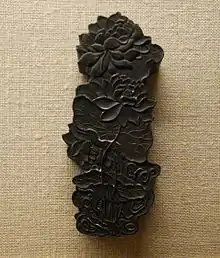
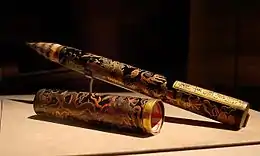 Ink brush with golden dragon design, used by the Ming Wanli Emperor (1563-1620), China
Ink brush with golden dragon design, used by the Ming Wanli Emperor (1563-1620), China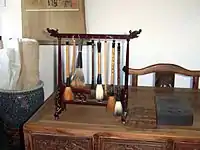 Reconstruction of Emperor Qianlong's (1711 – 1799) writing table, China
Reconstruction of Emperor Qianlong's (1711 – 1799) writing table, China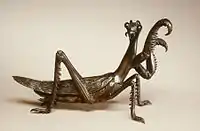 Brush rest in the shape of a praying mantis, China
Brush rest in the shape of a praying mantis, China

The earliest intact ink brush was found in 1954 in the tomb of a Chu citizen from the Warring States period (475-221 BCE) located in an archaeological dig site Zuo Gong Shan 15 near Changsha (長沙). The primitive version of an ink brush found had a wooden stalk and a bamboo tube securing the bundle of hair to the stalk. Legend wrongly credits the invention of the ink brush to the later Qin general Meng Tian.[17]
Traces of the writing brush, however, were discovered on the Shang jades, and were suggested to be the grounds of the oracle bone inscriptions.[18]
The writing brush entered a new stage of development in the Han dynasty. First, it created the decoration craft of engraving and inlaying on the pen-holder. Second, some writings on the production of writing brush appeared. For example, the first monograph on the selection, production and function of writing brush was written by Cai Yong in the eastern Han dynasty . Third, the special form of "hairpin white pen" appeared. Officials in the Han dynasty often sharpened the end of the brush and stuck it in their hair or hat for their convenience. Worshipers also often put pen on their heads to show respect.[17][8]
To The Yuan and Ming dynasty, Huzhou emerged a group of pen making experts, such as Wu Yunhui, Feng Yingke, Lu Wenbao, Zhang Tianxi, etc. Huzhou has been the center of Chinese brush making since the Qing dynasty. At the same time, there was many famous brushes in other places, such as Ruyang Liu brush in Henan province, Li Dinghe brush in Shanghai, Wu Yunhui in Jiangxi province.[17]
Ink wash painting is usually done on rice paper (Chinese) or washi (Japanese paper) both of which are highly absorbent and unsized. Silk is also used in some forms of ink painting.[19] Many types of xuan paper and washi do not lend themselves readily to a smooth wash the way watercolor paper does. Each brush stroke is visible, so any "wash" in the sense of Western style painting requires partially sized paper. Paper manufacturers today understand artists' demands for more versatile papers and work to produce kinds that are more flexible. If one uses traditional paper, the idea of an "ink wash" refers to a wet-on-wet technique, applying black ink to paper where a lighter ink has already been applied, or by quickly manipulating watery diluted ink once it has been applied to the paper by using a very large brush.[8]
In ink wash paintings, as in calligraphy, artists usually grind inkstick over an inkstone to obtain black ink, but prepared liquid inks (墨汁 in Japanese, bokuju) are also available. Most inksticks are made of soot from pine or oil combined with animal glue.[20] An artist puts a few drops of water on an inkstone and grinds the inkstick in a circular motion until a smooth, black ink of the desired concentration is made. Prepared liquid inks vary in viscosity, solubility, concentration, etc., but are in general more suitable for practicing Chinese calligraphy than executing paintings.[21] Inksticks themselves are sometimes ornately decorated with landscapes or flowers in bas-relief and some are highlighted with gold.[18][4]
Ink wash painting brushes are similar to the brushes used for calligraphy and are traditionally made from bamboo with goat, cattle, horse, sheep, rabbit, marten, badger, deer, boar and wolf hair. The brush hairs are tapered to a fine point, a feature vital to the style of wash paintings.[4][8]
Different brushes have different qualities. A small wolf-hair brush that is tapered to a fine point can deliver an even thin line of ink (much like a pen). A large wool brush (one variation called the big cloud) can hold a large volume of water and ink. When the big cloud brush rains down upon the paper, it delivers a graded swath of ink encompassing myriad shades of gray to black.[3][18]
Once a stroke is painted, it cannot be changed or erased. This makes ink and wash painting a technically demanding art-form requiring great skill, concentration, and years of training.[8][3]
Chinese artists and their influence on East Asia
.jpg.webp) Guo Xi, Early Spring, signed and dated 1072. 11th century, China. Hanging scroll, ink and color on silk 158.3x108.1. National Palace Museum, Taipei.
Guo Xi, Early Spring, signed and dated 1072. 11th century, China. Hanging scroll, ink and color on silk 158.3x108.1. National Palace Museum, Taipei. Liang Kai (Chinese: 梁楷, 1140-1210), Shakyamuni Emerging from the Mountains (Chinese: (出山釋迦圖). Hanging scroll, ink and color on silk, 117.6 x 51.9 cm. collected by Tokyo National Museum
Liang Kai (Chinese: 梁楷, 1140-1210), Shakyamuni Emerging from the Mountains (Chinese: (出山釋迦圖). Hanging scroll, ink and color on silk, 117.6 x 51.9 cm. collected by Tokyo National Museum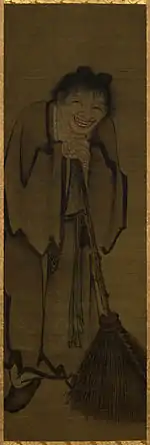 Yan Hui, Shi De (Chinese: 拾得). 13th century, Yuan Dynasty (Chinese). Color on silk. Tokyo National Museum
Yan Hui, Shi De (Chinese: 拾得). 13th century, Yuan Dynasty (Chinese). Color on silk. Tokyo National Museum.jpg.webp) Sesshū (1420–1506), Landscape, Mountain landscapes are by far the most common scenes depicted in ink wash landscape paintings.
Sesshū (1420–1506), Landscape, Mountain landscapes are by far the most common scenes depicted in ink wash landscape paintings.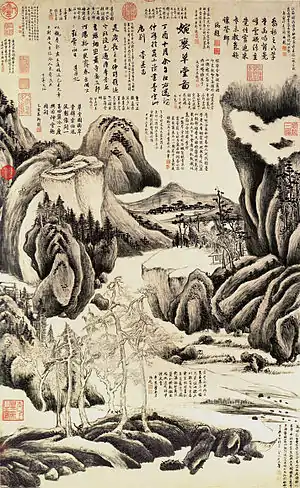 Dong Qichang, Landscape 1597. Dong Qichang was a high-ranking but cantankerous Ming civil servant, who valued expressiveness over delicacy, with collector's seals and poems.
Dong Qichang, Landscape 1597. Dong Qichang was a high-ranking but cantankerous Ming civil servant, who valued expressiveness over delicacy, with collector's seals and poems.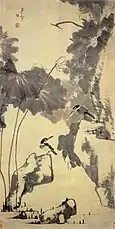 Zhu Da, Lotus and Birds, 17th century, Qing Dynasty, China, Shanghai Museum.
Zhu Da, Lotus and Birds, 17th century, Qing Dynasty, China, Shanghai Museum.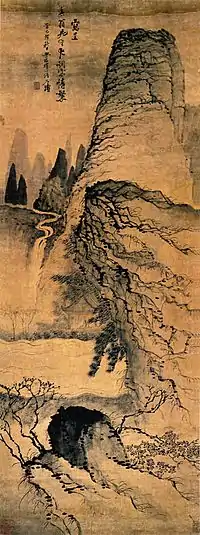 Shitao, Pine Pavilion Near a Spring, 1675, collection of the Shanghai Museum, 17th century, China.
Shitao, Pine Pavilion Near a Spring, 1675, collection of the Shanghai Museum, 17th century, China.
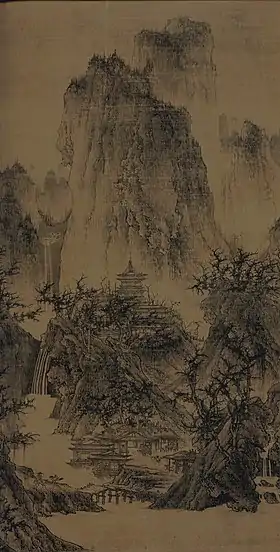
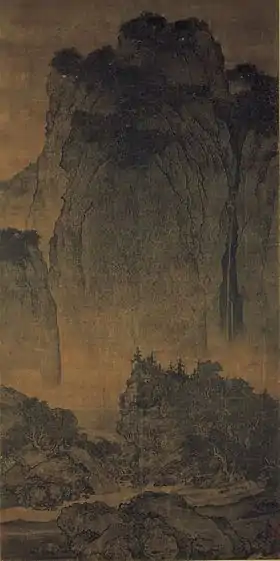



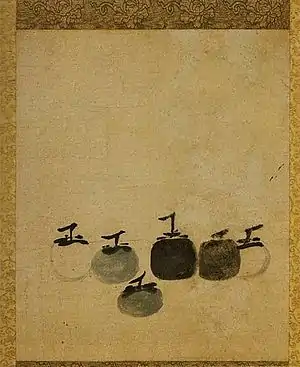




Tang, song and Yuan Dynasties
- Wang Wei (Chinese: 王維; 699–759) was a Chinese poet, musician, painter, and politician during the Tang dynasty, 8th century.[25]
- Zhang Zao (Chinese: 张璪, or 张藻) was a Chinese painter, painting theorist and politician during the Tang dynasty, 8th century.[26]
- Dong Yuan (Chinese: 董源; pinyin: Dŏng Yuán; Wade–Giles: Tung Yüan, Gan: dung3 ngion4; c. 934 – c. 962) was a Chinese painter.[27]:599
- Li Cheng (Chinese: 李成; pinyin: Lǐ Chéng; Wade–Giles: Li Ch'eng; 919–967), Courtesy name Xiánxī (咸熙), was a Chinese painter of the Song dynasty. He was influenced by Jing Hao, Juran. Li Cheng has a profound impact on Japanese and Korean painters.[28][29]
- Fan Kuan (Chinese: 范寬; pinyin: Fàn Kuān; Wade–Giles: Fan K’uan, c. 960 – c. 1030), courtesy name "Zhongli" and "Zhongzheng", better known by his pseudonym "Fan Kuan", was a Chinese landscape painter of the Song dynasty. He has a profound impact on Japanese and Korean paintings.[22] National Palace Museum, Taipei[23][30]
- Guo Xi (Chinese: 郭熙; pinyin: Guō Xī; Wade–Giles: Kuo Hsi) (c. 1020 – c. 1090)[31] was a Chinese landscape painter from Henan Province[32] who lived during the Northern Song dynasty. One text entitled "The Lofty Message of Forest and Streams" (Linquan Gaozhi 林泉高致) is attributed to him.[33]
- Su Shi (traditional Chinese: 蘇軾; simplified Chinese: 苏轼; 8 January 1037 – 24 August 1101), courtesy name Zizhan (Chinese: 子瞻), art name Dongpo (Chinese: 東坡), was a Chinese calligrapher, gastronome, painter, pharmacologist, poet, politician, and writer of the Song dynasty.[34]
- Mi Fu (Chinese: 米芾 or 米黻; pinyin: Mǐ Fú, also given as Mi Fei, 1051–1107)[35] was a Chinese painter, poet, and calligrapher born in Taiyuan during the Song dynasty.[36]
- Mi Youren (Chinese: 米友仁, 1074-1153) was a Chinese painter, poet, and calligrapher born in Taiyuan during the Song dynasty. He was the eldest son of Mi Fu.[37]
- Southern School (Chinese: 南宗画; pinyin: nán zōng huà) of Chinese painting, often called "literati painting" (文人画; wén rén huà), is a term used to denote art and artists which stand in opposition to the formal Northern School (北宗画; běi zōng huà) of painting. Representing painters are Wang Wei, Dong Yuan, and so on. It has a profound impact on Japanese and Southeast Asian paintings.[38]
- Northern School (Chinese: 北宗画; pinyin: běi zōng huà) was a manner of Chinese landscape painting centered on a loose group of artists who worked and lived in Northern China during the Five Dynasties period that occupied the time between the collapse of the Tang dynasty and the rise of the Song. Representing painters are Ma Yuan, Xia Gui, and so on. The style stands in opposition to the Southern School (南宗画; nán zōng huà) of Chinese painting. Northern School has a profound impact on Japanese and Southeast Asian paintings.[39]
- Ma Yuan (Chinese: 馬遠; pinyin: Mǎ Yuǎn; Wade–Giles: Ma Yüan; c. 1160–65 – 1225) was a Chinese painter of the Song dynasty. His works, together with that of Xia Gui, formed the basis of the so-called Ma-Xia (馬夏) school of painting, and are considered among the finest from the period. His works has inspired both Chinese artists of the Zhe School, as well as the great early Japanese painters Shūbun and Sesshū.[40]
- Xia Gui (Chinese: 夏圭 or 夏珪; Wade–Giles: Hsia Kui; fl. 1195–1224), courtesy name Yuyu (禹玉), was a Chinese landscape painter of the Song dynasty. Very little is known about his life, and only a few of his works survive, but he is generally considered one of China's greatest artists. He continued the tradition of Li Tang, further simplifying the earlier Song style to achieve a more immediate, striking effect. Together with Ma Yuan, he founded the so-called Ma-Xia (馬夏) school, one of the most important of the period. Although Xia was popular during his lifetime, his reputation suffered after his death, together with that of all Southern Song academy painters. Nevertheless, a few artists, including the Japanese master Sesshū, continued Xia's tradition for hundreds of years, until the early 17th century.[41]
- Liang Kai (Chinese: 梁楷; pinyin: Liáng Kǎi; c. 1140 - c. 1210) was a Chinese painter of the Southern Song Dynasty. He was also known as "Madman Liang" because of his very informal pictures.[42]
- Muqi (Chinese: 牧谿; Japanese: Mokkei; 1210?–1269?), also known as Fachang (Chinese: 法常), was a Chinese Chan Buddhist monk and painter who lived in the 13th century, around the end of the Southern Song dynasty (1127–1279). Today, he is considered to be one of the greatest Chan painters in history. His ink paintings, such as the Daitokuji triptych and Six Persimmons are regarded as essential Chan paintings.[43] Muqi's style of painting has also profoundly impacted painters from later periods to follow, especially monk painters in Japan.[44]
- Four Masters of the Yuan dynasty (Chinese: 元四家; pinyin: Yuán Sì Jiā) is a name used to collectively describe the four Chinese painters Huang Gongwang, Wu Zhen, Ni Zan, and Wang Meng, who were active during the Yuan dynasty (1271–1368). They were revered during the Ming dynasty and later periods as major exponents of the tradition of "literati painting" (wenrenhua), which was concerned more with individual expression and learning than with outward representation and immediate visual appeal.[45]
- Gao Kegong (simplified Chinese: 高克恭; traditional Chinese: 髙克恭; pinyin: Gaō Kègōng; Wade–Giles: Kao K'o-kung; 1248–1310) was a Chinese painter, and sometimes poet, born during the Yuan dynasty, he was known for his landscapes.[46]
- Yan Hui (simplified Chinese: 颜辉; traditional Chinese: 顏輝; pinyin: Yán Huī; Wade–Giles: Yen Hui); was a late 13th-century Chinese painter who lived during the Southern Song and early Yuan dynasties. Yan Hui's style of painting has also profoundly impacted the painters in Japan.[47]
Ming and Qing Dynasties
- Four Masters of the Ming dynasty (Chinese: 明四家; pinyin: Míng Sì Jiā) are a traditional grouping in Chinese art history of four famous Chinese painters of the Ming dynasty. The group are Shen Zhou (1427-1509), Wen Zhengming (1470-1559), both of the Wu School, Tang Yin (1470-1523), and Qiu Ying (c.1494-c.1552). They were approximate contemporaries, with Shen Zhou the teacher of Wen Zhengming, while the other two studied with Zhou Chen. Their styles and subject matter were varied.[48]
- Xu Wei (Chinese: 徐渭; pinyin: Xú Wèi; Wade–Giles: Hsü Wei, 1521–1593), other department "Qingteng Shanren" (Chinese: 青藤山人; pinyin: Qīngténg Shānrén), was a Ming dynasty Chinese painter, poet, writer and dramatist famed for his artistic expressiveness.[49]
- Chen Chun (Chinese: 陳淳; 1483–1544) was a Ming Dynasty artist. Born into a wealthy family of scholar-officials in Suzhou, he learned calligraphy from Wen Zhengming, one of the Four Masters of the Ming dynasty. Chén Chún later broke with Wen to favor a more freestyle method of ink wash painting.[50]
- Four Wangs (Chinese: 四王; pinyin: Sì Wáng; Wade–Giles: Ssŭ Wang) were four Chinese landscape painters in the 17th century, all called Wang (surname Wang). They are best known for their accomplishments in shan shui painting.They were Wang Shimin (1592–1680), Wang Jian (1598–1677), Wang Hui (1632–1717) and Wang Yuanqi (1642–1715).[27]:757
- Bada Shanren (Chinese: 朱耷; pinyin: zhū dā, born "Zhu Da"; c. 1626–1705), other department "Bada Shanren" (Chinese: 八大山人; pinyin: bā dà shān rén), was a Han Chinese painter of ink wash painting and a calligrapher. He was of royal descent, being a direct offspring of the Ming dynasty prince Zhu Quan who had a feudal establishment in Nanchang. Art historians have named him as a brilliant painter of the period.[51][52]
- Shitao (simplified Chinese: 石涛; traditional Chinese: 石濤; pinyin: Shí Tāo; Wade–Giles: Shih-t'ao; other department "Yuan Ji" (Chinese: 原濟; Chinese: 原济; pinyin: Yuán Jì), 1642–1707), born into the Ming dynasty imperial clan as "Zhu Ruoji" (朱若極), was one Chinese landscape painter in early Qing Dynasty (1636-1912).[53]
- Eight Eccentrics of Yangzhou (simplified Chinese: 扬州八怪; traditional Chinese: 揚州八怪; pinyin: Yángzhoū Bā Guài) is the name for a group of eight Chinese painters active in the eighteenth-century, who were known in the Qing Dynasty for rejecting the orthodox ideas about painting in favor of a style deemed expressive and individualist.[27]:668
- Xu Gu (simplified Chinese: 虚谷; traditional Chinese: 虛谷; pinyin: Xū Gǔ; Wade–Giles: Hsü Ku, 1824–1896) was a Chinese painter and poet during the Qing Dynasty (1644–1912).[54]
Modern Times
- Wu Changshuo (Chinese: 吳昌碩; pinyin: Wú Chāngshuò, 12 September 1844 – 29 November 1927, also romanised as Wu Changshi, Chinese: 吳昌石; pinyin: Wú Chāngshí), born Wu Junqing (Chinese: 吳俊卿; pinyin: Wú Jùnqīng), was a prominent painter, calligrapher and seal artist of the late Qing Period. Wu Changshuo's style of painting has profoundly impacted the paintings in Japan.[55]
- Wang Zhen (Chinese: 王震; Wade–Giles: Wang Chen; 1867–1938),[56] commonly known by his courtesy name Wang Yiting (Chinese: 王一亭; Wade–Giles: Wang I-t'ing), was a prominent businessman and celebrated modern Chinese artist of the Shanghai School.
- Pu Hua (Wade–Giles: P'u Hua, traditional: 蒲華, simplified: 蒲华, pinyin: Pú Huá); c. 1834–1911 was a Chinese landscape painter and calligrapher during the Qing Dynasty. His style name was 'Zuo Ying'. Pu painted landscapes and ink bamboo in an unconventional style of free and easy brush strokes.[57]
- Qi Baishi (simplified Chinese: 齐白石; traditional Chinese: 齊白石; pinyin: qí bái shí, simplified Chinese: 齐璜; traditional Chinese: 齊璜; pinyin: qí huáng1 January 1864 – 16 September 1957) was a Chinese painter, noted for the whimsical, often playful style of his ink wash painting works.[58]
- Huang Binhong (Chinese: 黃賓虹; pinyin: Huáng Bīnhóng; 1865–1955) was a Chinese literati painter and art historian born in Jinhua, Zhejiang province. His ancestral home was She County, Anhui province. He was the grandson of artist Huang Fengliu. He would later be associated with Shanghai and finally Hangzhou. He is considered one of the last innovators in the literati style of painting and is noted for his freehand landscapes.[49]:2056
- Pan Tianshou (simplified Chinese: 潘天寿; traditional Chinese: 潘天壽; pinyin: Pān Tiānshòu; 1897–1971) was a Chinese painter and art educator. Pan was born in Guanzhuang, Ninghai County, Zhejiang Province, and graduated from Zhejiang First Normal School (now Hangzhou High School). He studied Chinese traditional painting with Wu Changshuo, and built the foundation of Chinese traditional painting education. He was persecuted during the Cultural Revolution until his death in 1971.[59]
- Shi Lu (simplified Chinese: 石鲁; traditional Chinese: 石魯; pinyin: Shí Lǔ; 1919–1982), born "Feng Yaheng" (simplified Chinese: 冯亚珩; traditional Chinese: 馮亞珩; pinyin: Féng Yàhéng), was a Chinese painter, wood block printer, poet and calligrapher. He based his pseudonym on two artists who greatly influenced him, the landscape painter Shitao and writer Lu Xun.[60]
- Wu Zuoren (Chinese: 吴作人; pinyin: Wú Zuòrén; Wade–Giles: Wu Tso-jen; 3 November 1908 – 9 April 1997)[61] was a Chinese painter. A native of Jing County, Anhui, he was born in Suzhou, Jiangsu Province. He practiced both traditional Chinese ink painting and European oil painting.[62]
- Xu Beihong (Chinese: 徐悲鴻; Wade–Giles: Hsü Pei-hung; 19 July 1895 – 26 September 1953), also known as "Ju Péon", was a Chinese painter.[63] He was primarily known for his Chinese ink paintings of horses and birds and was one of the first Chinese artists to articulate the need for artistic expressions that reflected a modern China at the beginning of the 20th century. He was also regarded as one of the first to create monumental oil paintings with epic Chinese themes – a show of his high proficiency in an essential Western art technique.[64] He was one of the four pioneers of Chinese modern art who earned the title of "The Four Great Academy Presidents".[65]
- Liu Haisu (Chinese: 刘海粟; pinyin: Liú Hǎisù; 16 March 1896 – 7 August 1994) was a prominent twentieth-century Chinese painter and a noted art educator. He excelled in Chinese painting and oil painting. He was one of the four pioneers of Chinese modern art who earned the title of "The Four Great Academy Presidents".[66]
- Zhang Daqian (Chinese: 張大千; Wade–Giles: Chang Ta-ch'ien; 10 May 1899 – 2 April 1983) was one of the best-known and most prodigious Chinese artists of the twentieth century. Originally known as a guohua (traditionalist) painter, by the 1960s he was also renowned as a modern impressionist and expressionist painter. In addition, he is regarded as one of the most gifted master forgers of the twentieth century.[67]
Other countries in East Asia
Japan
- Josetsu (如拙, fl. 1405–1496) was one of the first suiboku (ink wash) style Zen Japanese painters in the Muromachi Period (15th century). He was probably also a teacher of Tenshō Shūbun at the Shōkoku-ji monastery in Kyoto. A Chinese immigrant, he was naturalised in 1470 and is known as the "Father of Japanese ink painting".[68]
- Tenshō Shūbun (天章 周文, died c. 1444–50) was a Japanese Zen Buddhist monk and painter of the Muromachi period. He was deeply influenced by the Northern School (北宗画; běi zōng huà) of Chinese painting and Josetsu.[69]
- Sesshū Tōyō (Japanese: 雪舟 等楊; Oda Tōyō since 1431, also known as Tōyō, Unkoku, or Bikeisai; 1420 – 26 August 1506) was the most prominent Japanese master of ink and wash painting from the middle Muromachi period. He was deeply influenced by the Northern School (北宗画; běi zōng huà) of Chinese painting, especially Ma Yuan and Xia Gui.[70]
- Hasegawa Tōhaku (長谷川 等伯, 1539 – 19 March 1610) was a Japanese painter and founder of the Hasegawa school. He is considered one of the great painters of the Azuchi–Momoyama period (1573-1603), and he is best known for his byōbu folding screens, such as Pine Trees and Pine Tree and Flowering Plants (both registered National Treasures), or the paintings in walls and sliding doors at Chishaku-in, attributed to him and his son (also National Treasures). He was deeply influenced by Chinese painting of Song Dynasty, especially Liang Kai and Muqi.[71][72]
- Ike no Taiga (池大雅, 1723–1776) was a Japanese painter and calligrapher born in Kyoto during the Edo period. Together with Yosa Buson, he perfected the bunjinga (or nanga) genre. The majority of his works reflected his passion for classical Chinese culture and painting techniques, though he also incorporated revolutionary and modern techniques into his otherwise very traditional paintings. As a bunjin (文人, literati, man of letters), Ike was close to many of the prominent social and artistic circles in Kyoto, and in other parts of the country, throughout his lifetime.[73]
Korea
- An Gyeon was a painter of the early Joseon period. He was born in Jigok, Seosan, Chungcheongnam-do. He entered royal service as a member of the Dohwaseo, the official painters of the Joseon court, and drew Mongyu dowondo (몽유도원도) for Prince Anpyeong in 1447 which is currently stored at Tenri University. He was deeply influenced by the Southern School (Chinese: 南宗画; pinyin: nán zōng huà) of Chinese painting, especially Li Cheng and Guo Xi.[74]
- Byeon Sang-byeok was a Korean painter of the Miryang Byeon clan during the late period of the Korean Joseon Dynasty (1392–1910). Byeon is famous for his precise depictions of animals and people in detailed brushwork. Byeon was deeply influenced by the Imperial-court Decorative Painting (Chinese: 院體畫; pinyin: Yuàn Tǐ Huà) of Chinese painting, especially Huang Quan.[75][76]
- Gang Hui-an (1417?-1464), pen name Injae 인재, was a prominent scholar and painter of the early Joseon period. He was good at poetry, calligraphy, and painting. He entered royal service by passing gwageo in 1441 under the reign of king Sejong (1397–1418–1450).[77][78][79][80][81]
- Nam Gye-u (1811–1888) was a painter and a government officer in the late Joseon period. Nam Gyewu was born to a high class and son of Nam Jinhwa who served as Busa. He lived in Namchon, Seoul and had an official career as Dojeong. Nam was especially good at depicting butterflies, so called as Nam Nabi (Butterfly Nam), his nickname. Through his lifetime, Nam Gye-u devoted to drawing pictures of butterflies and flowers.[82]
- Kim Hong-do (김홍도, born 1745, died 1806?-1814?), also known as "Kim Hong-do", most often styled "Danwon" (단원), was a full-time painter of the Joseon period of Korea. He was together a pillar of the establishment and a key figure of the new trends of his time, the 'true view painting'. Gim Hong-do was an exceptional artist in every field of traditional painting, even if he is mostly remembered nowadays for his depictions of the everyday life of ordinary people, in a manner analogous to the Dutch Masters.[83]
- Shin Yun-bok better known by his pen name Hyewon (1758–1813), was a Korean painter of the Joseon Dynasty. Like his contemporaries Danwon and Geungjae, he is known for his realistic depictions of daily life in his time. His genre paintings are distinctly more erotic than Danwon's, a fact which contributed to his expulsion from the royal painting institute, Dohwaseo.[84]
- Jang Seung-eop (1843–1897) (commonly known by his pen name "Owon") was a painter of the late Joseon Dynasty in Korea. His life was dramatized in the award-winning 2002 film Chi-hwa-seon directed by Im Kwon-taek. He was one of the few painters to hold a position of rank in the Joseon court.
- Jeong Seon (Korean: 정선) (1676–1759) was a Korean landscape painter, also known by his pen name "Kyomjae" ("humble study"). His works include ink and oriental water paintings, such as Inwangjesaekdo (1751), Geumgang jeondo (1734), and Ingokjeongsa (1742), as well as numerous "true-view" landscape paintings on the subject of Korea and the history of its culture. He is counted among the most famous Korean painters.[85] His style is realistic rather than abstract.[86]
See also
Notes
- simplified Chinese: 水墨画; traditional Chinese: 水墨畫; pinyin: shuǐmòhuà; Japanese: 水墨画, romanized: suiboku-ga or Japanese: 墨絵, romanized: sumi-e; Korean: 수묵화, romanized: sumukhwa.
- Sharron Gu (22 December 2011). A Cultural History of the Chinese Language. McFarland. pp. 99–100. ISBN 978-0-7864-8827-8.
- Lu Yilong (30 December 2015). The History and Spirit of Chinese Art (2-Volume Set). Enrich Professional Publishing Limited. p. 178. ISBN 978-1-62320-130-2.
- The Editorial Committee of Chinese Civilization: A Source Book, City University of Hong Kong (1 April 2007). China: Five Thousand Years of History and Civilization. City University of HK Press. p. 732–3. ISBN 978-962-937-140-1.
- Dorothy Perkins (19 November 2013). Encyclopedia of China: History and Culture. Routledge. p. 232. ISBN 978-1-135-93562-7.
- Jenyns, 177-118
- Jenyns, 152-158
- Watson, William, Style in the Arts of China, 1974, Penguin, p. 86-88, ISBN 0140218637
- Fred S. Kleiner (5 January 2009). Gardner's Art through the Ages: Non-Western Perspectives. Cengage Learning. p. 81. ISBN 978-0-495-57367-8.
- Marco, Meccarelli. 2015. "Chinese Painters in Nagasaki: Style and Artistic Contaminatio during the Tokugawa Period (1603–1868)" Ming Qing Studies 2015, Pages 175–236.
- Stanley-Baker, 118-124
- Stanley-Baker, 126-129
- Stanley-Baker, 132-134, 148-50
- Dunn, 361-363
- Dunn, 367-368
- Dow, Arthur Wesley (1899). Composition.
- Kwo, Da-Wei (October 1990). Chinese brushwork in calligraphy and painting : its history, aesthetics, and techniques (Dover ed.). Mineola, N.Y. ISBN 0486264815. OCLC 21875564.
- Cambridge History of Ancient China, 1999:108-112
- Jenyns, 120-122
- Jenyns, 123
- Okamoto, Naomi The Art of Sumi-e: Beautiful ink painting using Japanese Brushwork, Search Press, Kent UK, 2015, p. 16
- Ebrey, Cambridge Illustrated History of China, 162.
- Liu, 50.
- Sickman, 219-220
- bio dates: Ch'en and Bullock, 49 and 53; Stimson, 22; Watson, 10 and 170; and Wu, 225. Note, however, other sources, such as Chang, 58, and Davis, x, give his years as 701–761
- "Zhang Zao". Boya Renwu.
- Cihai: Ci hai bian ji wei yuan hui (辭海編輯委員會). Ci hai (辭海). Shanghai: Shanghai ci shu chu ban she (上海辭書出版社), 1979.
- "Chinese painting - Five Dynasties (907-960) and Ten Kingdoms (902-978)". Encyclopedia Britannica. Retrieved 25 May 2017.
- Sturgeon, Donald. "宣和画谱 - Chinese Text Project". ctext.org. Retrieved 25 May 2017.
- Conrad Schirokauer; Miranda Brown; David Lurie; Suzanne Gay (1 January 2012). A Brief History of Chinese and Japanese Civilizations. Cengage Learning. p. 223. ISBN 978-0-495-91322-1.
- Barnhart: Page 372. Guo Xi's style name was Chunfu (淳夫)
- Ci hai: Page 452
- Hearn, Maxwell K. Cultivated Landscapes: Chinese Paintings from the Collection of Marie-Hélène and Guy Weill. New York: The Metropolitan Museum of Art, Yale University Press, 2002.
- "Su Shi-Song Dynasty". China Online Museum.
- Barnhart: 373. His courtesy name was Yuanzhang (元章) with several sobriquets: Nangong (南宮), Lumen Jushi (鹿門居士), Xiangyang Manshi (襄陽漫士), and Haiyue Waishi (海岳外史)
- "米芾的書畫世界 The Calligraphic World of Mi Fu's Art". Taipei: National Palace Museum. 2006. Archived from the original on 23 September 2013.
- "Mi Youren". Boya Renwu.
- Sickman, 334
- Barnhart, "Three Thousand Years of Chinese Painting", 93.
- Little, Stephen; Eichman, Shawn; Shipper, Kristofer; Ebrey, Patricia Buckley (1 January 2000). Taoism and the Arts of China. University of California Press. p. 160. ISBN 978-0-520-22785-9.
- Barnhart, "Three Thousand Years of Chinese Painting", 96.
- Shen, Zhiyu (1981). The Shanghai Museum of Art. New York: Harry N. Abrams, Inc. pp. 223–224. ISBN 0-8109-1646-0.
- Lachman, Charles (2005). "Art". In Lopez, Donald S. (ed.). Critical terms for the study of Buddhism. Chicago: University of Chicago Press. pp. 4~5. ISBN 9780226493237. OCLC 270606633.
- Rio, Aaron (2015). Ink painting in medieval kamakura. pp. 67~113.
- Farrer, 115-116; 339-340
- "Gao Kegong". Boya Renwu.
- "Yan Hui". Boya Renwu.
- Rawson, p. 340
- Cihai: Page 802.
- "Painting Gallery of Chen Chun". China Online Museum.
- Glaze, Anna. Landscapes, Tradition, and the Seventeenth-Century Art Market: A Different Side of Bada Shanren. Master's Thesis, University of California, Davis., June, 2008.
- China: five thousand years of history and civilization. Hong Kong: City University of Hong Kong Press. 2007. p. 761. ISBN 978-962-937-140-1.
- Hay 2001, pp. 1, 84
- "Xū Gǔ Brief Biography". Retrieved 17 July 2008.
- "Wu Changshuo". Boya Renwu.
- Encyclopedia of Chinese Artists (Zhongguo meishu jia renming cidian) on p. 131
- "Pú Huá Brief Biography". Retrieved 17 July 2008.
- "Qi Baishi's paintings". China Online Museum.
- King, Richard; Croizier, Ralph; Zheng, Shentian; Watson, Scott, eds. (2010). Art in Turmoil: The Chinese Cultural Revolution, 1966-76. University of British Columbia Press. pp. 97–98. ISBN 978-0774815437.
- Hawkins (2010), p. .
- Barnhart, R. M. et al. (1997). Three thousand years of Chinese painting. New Haven, Yale University Press. ISBN 0-300-07013-6: Page 384.
- "Wu Zuoren". Official website of Wu Zuoren International Foundation of Fine Arts.
- 毕楠. "Five major works of Xu Beihong that shouldn't be missed - Chinadaily.com.cn". China Daily. Retrieved 20 November 2019.
- "Singapore Art Museum (SAM) opens 'Xu Beihong in Nanyang' a Solo Exhibition". Art Knowledge News. Archived from the original on 28 June 2010. Retrieved 18 June 2008.
- "PROPERTY FROM AN IMPORTANT PRIVATE ASIAN COLLECTION-Yan Wenliang".
- "PROPERTY FROM AN IMPORTANT PRIVATE ASIAN COLLECTION-Yan Wenliang".
- Zhu, Haoyun (2012). "Zhang Daqian: A World-renowned Artist". China & the World Cultural Exchange. 12: 18–23.
- "Taiko Josetsu". Britannica article. Archived from the original on 16 May 2005.
- Nussbaum, Louis-Frédéric. (2005). "Shūbun" in Japan Encyclopedia, p. 889, p. 8890, at Google Books
- Appert, Georges. (1888). Ancien Japon, p. 80.
- "Suiboku-ga." Encyclopædia Britannica Online. 10 Dec. 2009
- HASEGAWA Tohaku (1539–1610) Archived 2009-12-08 at the Wayback Machine Mibura-Dera Temple Website. 10 Dec 2009
- Marco, Meccarelli. 2015. "Chinese Painters in Nagasaki: Style and Artistic Contaminatio during the Tokugawa Period (1603-1868)" Ming Qing Studies 2015, Pages 175-236.
- "An Gyeon". yonhapnews.
- Yi Sŏng-mi (2008). "Euigwe and the Documentation of Joseon Court Ritual Life". Archives of Asian Art (in Korean). 58: 113–133. doi:10.1353/aaa.0.0003. ISSN 1944-6497. Retrieved 14 November 2009.
- 國手 [Guksu] (in Korean). Nate Korean-Hanja Dictionary. Archived from the original on 14 July 2011. Retrieved 14 November 2009.
- TWA 2013
- (in Korean) http://artne.com/artfair/m_mall_detail.php?ps_ctid=01020100&ps_goid=8
- (in Korean) Naver. http://terms.naver.com/entry.nhn?cid=200000000&docId=1057487&categoryId=200001108
- (in Korean) Britannica. http://preview.britannica.co.kr/bol/topic.asp?mtt_id=2181 Archived 2013-07-02 at Archive.today
- (in Korean) http://art2me.org/images/gamsang/KoreanArt/gangheuian.htm Archived 2017-04-20 at the Wayback Machine
- "Brief biography". koreandb (in Korean).
- Turner 2003, p. (18)53
- Choi Yongbeom (최용범), Reading Korean history in one night (하룻밤에 읽는 한국사) p299, Paper Road, Seoul, 2007. ISBN 89-958266-3-0.
- "Gyeomjae Jeong seon Memorial Museum, Korea". asemus. Retrieved 22 December 2014.
- Ah-young, Chung (15 September 2009). "Jeong Seon's Paintings Brought to Life". The Korea Times. Archived from the original on 22 December 2014. Retrieved 22 December 2014.
References
- "Cihai": Ci hai bian ji wei yuan hui (辞海编辑委员会). Ci hai (辞海). Shanghai: Shanghai ci shu chu ban she (上海辞书出版社), 1979.
- Dunn, Michael, The Art of East Asia, ed. Gabriele Fahr-Becker, Volume 2, 1998, Könemann, ISBN 3829017456
- Farrer, Anne, in Rawson, Jessica (ed). The British Museum Book of Chinese Art, 2007 (2nd edn), British Museum Press, ISBN 9780714124469
- Jenyns, Soame, A Background to Chinese Painting (with a Preface for Collectors by W. W. Winkworth), 1935, Sidgwick & Jackson, Ltd
- Rawson, Jessica (ed). The British Museum Book of Chinese Art, 2007 (2nd edn), British Museum Press, ISBN 9780714124469
- Sickman, Laurence, in: Sickman L. & Soper A., The Art and Architecture of China, Pelican History of Art, 3rd ed 1971, Penguin (now Yale History of Art), LOC 70-125675
- Stanley-Baker, Joan, Japanese Art, 2000 (2nd edn), Thames and Hudson, World of Art, ISBN 0500203261
External links
| Wikimedia Commons has media related to Ink and wash paintings. |